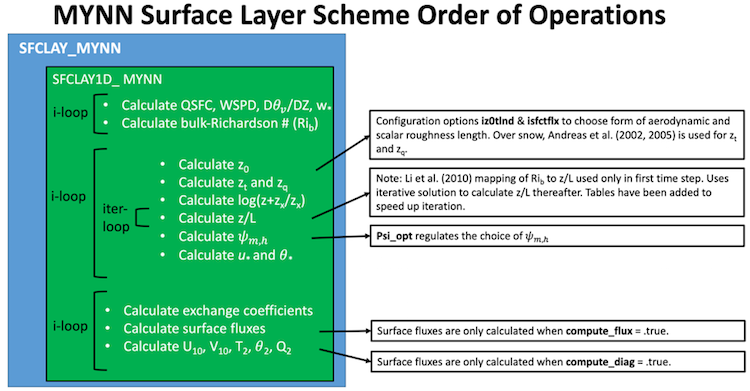The surface layer scheme controls the degree of coupling between the model surface and the atmosphere. Traditionally, surface layer schemes have been developed to be paired with certain PBL schemes, but this pairing is too narrow-scoped, since the surface layer physics should be equally as integrated with the land-surface model (LSM), modern gravity wave drag suites, and wave models. The expansion of model complexity, such as the inclusion of subgrid-scale landuse variations, vertically distributed sources of drag [i.e., wind farm drag (Fitch et al. 2012 [60] ), small-scale gravity wave drag (Steeneveld et al. 2008 [179]) and topographic form drag (Beljaars et al. 2004) [15] ], requires that surface layer scheme be developed within a broader context so assumptions made across all model components are physically consistent.
The MYNN surface layer scheme was originally developed for the Mellor-Yamada-Nakanishi-Niino (MYNN)-Eddy Diffusivity-Mass Flux (EDMF) scheme (Nakanishi and Niino 2009 [141], Olson et al. 2019 [149]) and has been used in NOAA's operational Rapid Refresh (RAP; Benjamin et al. 2016 [24] ) and High-Resolution Rapid Refresh (HRRR) forecast systems since 2014. During this time, the scheme has undergone significant development in tandem with other components of the forecast systems. More recently, several new features have been added in order to accommodate different capabilities in the Common Community Physics Package (CCPP) (Heinzeller et al. 2019). This updated version of the surface layer scheme is a candidate to be used in the Rapid Refresh Forecast System (RRFS), which is a component of NOAA's Unified Forecast System, and a successor to the RAP/HRRR forecast systems.
The surface layer schemes in CCPP only compute transfer coefficients and pass them to other modules that compute the surface fluxes and 2-m and 10-m diagnostics. Therefore, switches were added to bypass the calculation of surface fluxes and diagnostics for typical use, but kept as an option to used in idealized model configurations.
The surface layer physics represented by the scheme utilizes traditional Monin-Obukhov stability theory (MOST) (Monin and Obukhov 1954 [9] ), which is not novel, but still represents a respectable performance benchmark. This scheme is built in a modular sense, which allows for flexible testing of a variety of different subcomponents within the MOST-type bulk-flux algorithm. The specific subcomponents that exploit this modular design include the specification of the surface roughness lengths, the scalar roughness lengths, and the flux-profile relationships (a.k.a. stability functions). The configuration options for testing different forms of these subcomponents will be discussed below.
The surface-layer scheme is call directly after the radiation and prior to the surface modules (land-surface, sea-ice, and sea-surface temperature models). The surface layer scheme and the surface modules collectively calculate the necessary input for the boundary-layer schemes (beyond the basic state variables): u*, z/L, surface heat and moisture fluxes.

Within the MYNN surface layer scheme, there is a dependency check for the first timestep. If true, several arrays are initialized at every i point. This is done because (1) some variables are calculated in schemes called after the surface layer call and (2) some variables are used within iterative processes and may not be specified until later in the surface layer scheme. The main order of operations and hightlight relevant subroutines in sfclay1d_mynn().